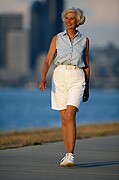Light Exercise Might Reduce Risk of Kidney Stones
Intensity of activity doesn't seem to matter, study finds.
Just a little exercise each week -- jogging for an hour or walking for about three hours -- can reduce the risk of developing kidney stones by up to 31 percent, according to a new study.

Researchers looking at data on more than 84,000 postmenopausal women found that engaging in any type of light physical activity can help prevent the formation of these pebbles in the kidneys. Even light gardening might curb their development, according to the study.
Even small amounts of exercise may decrease the risk of kidney stones. It does not need to be marathons, as the intensity of the exercise does not seem to matter.
Kidney stones, which have become increasingly common, are more prevalent among women. During the past 15 years, research has shown that kidney stones might actually be a systemic problem, involving more than just the kidneys. Recent research has linked the stones to obesity, diabetes, metabolic syndrome and heart disease.
In conducting the study, the researchers analyzed information compiled since the 1990s on the women's eating habits and level of physical activity.
After taking into account the women's body-mass index (a measurement of body fat based on a ratio of height and weight), the researchers found that obesity was a risk factor for the development of kidney stones. Eating more than 2,200 calories a day could increase the risk for kidney stones by up to 42 percent.
"Being aware of calorie intake, watching their weight and making efforts to exercise are important factors for improving the health of our patients overall, and as it relates to kidney stones.
The study included only postmenopausal women, must be replicated in a larger, more diverse population. Women who engage in regular physical activity also likely have other healthy habits that help lower their risk for kidney stones.
Nevertheless, conservative counseling for patients with stones often centers almost exclusively on diet, stressing increased fluid intake, normal dietary calcium, lower sodium, moderate protein and reduced dietary oxalate.
The results of this study suggest that a recommendation for moderate physical activity might reasonably be added to the mix.
Each year in the United States, more than 300,000 people go to emergency rooms for kidney stone problems. Larger stones can get stuck in the urinary tract and block the flow of urine, causing severe pain or bleeding.
Source: HealthDay News
- 386 reads
Human Rights
Fostering a More Humane World: The 28th Eurasian Economic Summi

Conscience, Hope, and Action: Keys to Global Peace and Sustainability

Ringing FOWPAL’s Peace Bell for the World:Nobel Peace Prize Laureates’ Visions and Actions

Protecting the World’s Cultural Diversity for a Sustainable Future

Puppet Show I International Friendship Day 2020

